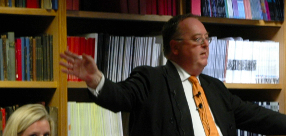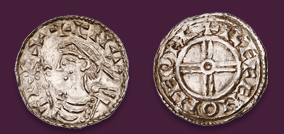
Auction: 25007 - … British and World Coins and Medals featuring The Oriole Collection of Gold and Silver English Coins
Lot: 429
Royal Academy of Arts, AR Award Medal, instituted 1768, awarded 1810 to Lewis Vulliamy, by T. Pingo, GEORGIVS III D . G . MAGN . BRIT . FR . ET HIB . REX, bust right, hair in fillet, rev. STVDY, torso seated, R . AC . INSTITVTED 1768, in exergue in two lines, GIVEN TO LEWIS VUILLAMY FOR THE BEST DRAWING IN ARCHITECTURE, DEC. 1810. on edge, 55mm, 93.75g (Eimer 724; BHM 133), previously cleaned and with some silver residue to the recesses, with light bagmarking, nonetheless subsequently retoned, nearing extremely fine
Lewis Vulliamy (15 March 1791- 4 January 1871), was an English architect best known for his work on large private houses and churches. He was born in Pall Mall, London on 15 March 1791 to Benjamin Vulliamy (1747-1811), a third-generation clock maker who received a royal appointment as the King's Clockmaker in 1773. Benjamin is best remembered for building the Regulator Clock, which between 1780 and 1884, was the main timekeeper of the King's Observatory at Kew.
The Vulliamy family moved to London from Switzerland in the 1730s. For over a hundred years the family's clockmaking business was based at 68 Pall Mall. Upon the death of Benjamin in 1811, the business was inherited by Lewis's brother Benjamin Lewis. At this time the company was known for its highly decorative clocks, objects d'art and furnishings made from metal, alongside watches and regulators. An engineering and architectural flare was also present in the work of Benjamin Lewis. He was an Associate member of the Institution of Civil Engineers and produced several turret clocks for modern buildings. He was even commissioned by the architect Sir Charles Barry to produce a design for the 'Big Ben' clock; however, it was rejected in favour of the work of Edward John Dent. Under his headship the business continued to produce pieces for the highest echelons of society including the Royal family up until the reign of Victoria.
This interest in engineering and architecture was greater shared by Lewis, who in 1809 was admitted to the Royal Academy Schools to study architectural drawing. In 1810 he was awarded this silver medal for 'THE BEST DRAWING IN ARCHITECTURE', this was followed by a gold medal in 1813. He was elected Royal Academy travelling student in 1818, after which he studied abroad for four years, mostly in Italy but also Greece and Asia Minor. From 1822 he exhibited at the Academy. Records reveal that while studying in Malta in 1820, he wrote to Henry Howard, Secretary of the Royal Academy of Arts, seeking to explain why he was delayed in submitting his work. He also asked for an extension, exclaiming that he would not draw from his allowance until he had heard back from the Academy.
He was articled to architect Sir Robert Smirke, best known as a leader within the Greek Revival movement. Smirke designed work for many public buildings, including the main block and façade of the British Museum as well as modifications which were made to the Royal Mint.
On Vulliamy's return to England, he established a practice on Oxford Street. His most notable works include those he completed for his major patron, Robert Stayner Holford, on Westonbirt House, Gloucestershire and the London residence Dorchester House, Park Lane. The latter was demolished in 1929 to make way for the Dorchester Hotel. Other works include the Law society, Chancery Lane, 1831 and Connaught Hall, Tavistock square, 1825-1826.
Following the Church Building Acts of 1818 and 1824, he became involved with the Church Commissioners. He ended up designing at least 14 churches for the Commissioners, including St Michael's in Highgate, Holy Trinty in Burnley and alternations to Rochester Cathedral, amongst many others.
Following struggles with bronchitis, Vulliamy died at his home on Clapham Common in 1871, his estate was valued at £60,000 (equivalent to £7,060,000 in 2023).
Of his five children, two followed in his architectural footsteps, however it is his nephew George John Vulliamy who is best remembered within the architectural field. He worked under both his uncle and Sir Charles Barry, later going on to elected superintending architect to the Metropolitan Board of Works. He designed the pedestal and sphinxes for Cleopatra's Needle on the embankment as well as the iconic Dolphin lamp standards and camel benches of the London embankment.
Subject to 20% VAT on Buyer’s Premium. For more information please view Terms and Conditions for Buyers.
Estimate
£300 to £400
Starting price
£210




